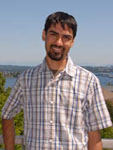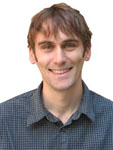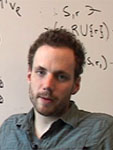 Since 1999, the editors of Technology Review have honored the young innovators whose inventions and research they find most exciting; today that collection is the TR35, a list of technologists and scientists, all under the age of 35. Selected from more than 300 nominees by a panel of expert judges and the editorial staff of Technology Review, the TR35 is an elite group of accomplished young innovators who exemplify the spirit of innovation. Their work – spanning medicine, computing, communications, electronics, nanotechnology, and more – is changing our world.
Since 1999, the editors of Technology Review have honored the young innovators whose inventions and research they find most exciting; today that collection is the TR35, a list of technologists and scientists, all under the age of 35. Selected from more than 300 nominees by a panel of expert judges and the editorial staff of Technology Review, the TR35 is an elite group of accomplished young innovators who exemplify the spirit of innovation. Their work – spanning medicine, computing, communications, electronics, nanotechnology, and more – is changing our world.
Once again, UW CSE friends and family have scored big in the TR35:
 UW CSE professor Shwetak Patel is recognized for using simple sensors to detect residents’ activities. Patel has shown that each electrical appliance in a house produces a signature in the building’s wiring; plugged into any outlet, a single sensor that picks up electrical variations in the power lines can detect the signal made by every device as it’s turned on or off. This monitoring ability could be particularly useful for elder care or for residential or business power conservation, but there was previously no practical way to achieve it, because it would have required numerous expensive sensors. (See TR35 article here.)
UW CSE professor Shwetak Patel is recognized for using simple sensors to detect residents’ activities. Patel has shown that each electrical appliance in a house produces a signature in the building’s wiring; plugged into any outlet, a single sensor that picks up electrical variations in the power lines can detect the signal made by every device as it’s turned on or off. This monitoring ability could be particularly useful for elder care or for residential or business power conservation, but there was previously no practical way to achieve it, because it would have required numerous expensive sensors. (See TR35 article here.)
 UW CSE’s recent Ph.D. alumnus Jeff Bigham, who will join the University of Rochester as a faculty member this month, is recognized for his work on WebAnywhere, a free screen reader for the sight-impaired that can be used with practically any Web browser on any operating system – no special software required. Users start at webanywhere.cs.washington.edu; from there, they can use keyboard commands to navigate to any Web page. (See TR35 article here.)
UW CSE’s recent Ph.D. alumnus Jeff Bigham, who will join the University of Rochester as a faculty member this month, is recognized for his work on WebAnywhere, a free screen reader for the sight-impaired that can be used with practically any Web browser on any operating system – no special software required. Users start at webanywhere.cs.washington.edu; from there, they can use keyboard commands to navigate to any Web page. (See TR35 article here.)
 UW CSE’s recent Ph.D. alumnus Adrien Treuille, who joined the Carnegie Mellon faculty last fall, is recognized for his work on complex physics simulations for computer animation and games that can run on everyday PCs. While a grad student, he and fellow CSE grad student Seth Cooper worked with CSE professor Zoran Popovic and UW biochemist David Baker to design a web game called Foldit (http://fold.it/) that allows players to compete in finding minimum-energy folds in proteins, aiding Baker’s world-reknowned research. More than 90,000 users have registered and played since the game’s launch in May 2008. Treuille wonders if someone – most likely even an amateur, since teenage gamers are beating the pants off Ph.D. biochemists at the game – might someday use Foldit to help discover a protein that cures cancer. (See TR35 article here.)
UW CSE’s recent Ph.D. alumnus Adrien Treuille, who joined the Carnegie Mellon faculty last fall, is recognized for his work on complex physics simulations for computer animation and games that can run on everyday PCs. While a grad student, he and fellow CSE grad student Seth Cooper worked with CSE professor Zoran Popovic and UW biochemist David Baker to design a web game called Foldit (http://fold.it/) that allows players to compete in finding minimum-energy folds in proteins, aiding Baker’s world-reknowned research. More than 90,000 users have registered and played since the game’s launch in May 2008. Treuille wonders if someone – most likely even an amateur, since teenage gamers are beating the pants off Ph.D. biochemists at the game – might someday use Foldit to help discover a protein that cures cancer. (See TR35 article here.)
University of Massachusetts professor Kevin Fu was also recognized for work on the security and privacy of implantable medical devices, a collaboration with UW CSE professor Yoshi Kohno, who was recognized by the TR35 two years ago. (See TR35 article here.)
Congratulations to Shwetak, Jeff, Adrien, and Kevin! It’s been a great few years for UW CSE in the TR35. In 2008, the TR-35 recognized UW CSE affiliate faculty members Tanzeem Choudhury (Dartmouth) and Merrie Morris (Microsoft Research), and close collaborator Blaise Aguera y Arcas (Microsoft LiveLabs). In 2007, the TR-35 recognized UW CSE professor Yoshi Kohno, UW CSE graduate student Tapan Parikh (now a faculty member at UC Berkeley), UW CSE Ph.D. alumna Karen Liu (now a faculty member at USC), and UW CSE affiliate faculty member Desney Tan (Microsoft Research).
Go team! See the full list of this year’s winners here.

